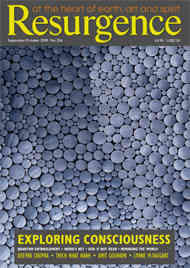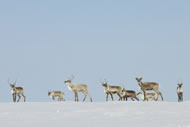Arctic Village, Alaska is a quintessentially American place. Located in the southern foothills of the Brooks Range, it is an Indigenous Gwichi’in Nation community, part of an Athabaskan territory that stretches across interior Alaska and north-west Canada. According to most scientists, the site of Arctic Village was home to an ancient Beringian ice-age culture, mother of almost all Native American cultures to the south. With cultural remains nearby dating back at least 15,000 years, Arctic Village may occupy the oldest place of habitation in all the Americas.
In the harshest of climates, the Gwichi’in have managed to flourish in the area for about 5,000 years, their lives based on an intimate relationship with lake-dotted river valleys full of roots, berries, whitefish, muskrats, ducks, and other animals, but it is the vadzaih, the caribou, that has become synonymous with their culture. Arctic Village caribou hunters like Jimmy John and Charley Swaney carry on a tradition that has sustained the Gwichi’in through seventy-below-zero winters, has provided clothing, shelter and tools, and has supplied potlatches, funerals and other ceremonies for millennia.
In 1988, members of the Gwichi’in Nation, ‘the people of the caribou’, gathered to prevent oil drilling on caribou calving grounds in the coastal plain of the Arctic National Wildlife Refuge, “the sacred place where life begins”. Now, having deterred oil drilling, the people of the caribou face another threat.
From 1980 to 2001, the head-count of the Porcupine Herd dropped from 189,000 to 120,000 – some experts guess it’s now low as 100,000. Respected wildlife biologist Dave Klein, professor emeritus of the University of Alaska, attributes the decline to climate disruption. And most of the adults in the village will report the consequences in detail themselves, adding that the elders began observing and predicting this decades ago.
In December this year, based on a growing scientific consensus about global climate change, the United Nations will be replacing the Kyoto protocol on climate change – never ratified by the US Senate – with the Copenhagen protocol, which the US might throw its weight behind. According to Indigenous participants in the process, the UN deliberations seem to largely ignore the urgent stories coming from places like Arctic Village, along with pressing concerns about Indigenous territorial rights, and protection against displacement. The prevailing sentiment essentially seems to permit pollution as long as polluters buy a range of ‘carbon offset’ projects, from carbon-sink forest reserves to biofuel plantations – projects that disproportionately target Indigenous territories worldwide.
A small but increasingly vocal minority has begun pointing out the plan’s fatal flaw: while it promises money to Indigenous communities, it does not adequately address the relatively severe impacts of climate change on those communities, or protect their territorial rights. And that doesn’t bode well for the rest of us. Indigenous peoples are not only harbingers of the impacts of climate disruption, but also sources of traditional wisdom and adaptation strategies – the very people who need to be supported on their land, and respectfully heeded, for the survival of the species.
IN THE TUNDRA, the complex signs of climate disruption start with simple factors: drier summers, erratic snow, abrupt temperature shifts, but above all melting permafrost, with its trademark tilting trees. When the permafrost melts, whole lakes disappear – they just dry up outright, or their dams crumble and the spillage disperses. Arctic Village residents have counted eighteen vanished lakes in the area, entire ecosystems perished. And then there’s the erosion of riverbanks, which silts up the flow, making the river shallower and thus warmer, disrupting aquatic sustenance.
The Porcupine Herd undertakes one of the longest annual migrations on Earth: a momentous 2,700-mile circuit back and forth over the Brooks Range. The Arctic melt does provide some help for caribou, like more marsh sedge to eat. But by and large the impacts are negative: new tree roots tap the sponge-like melt, taller spruce shade the light-dependent lichen that caribou eat, and new willows grow so thick that the caribou can’t cross rivers and must “drag ass” on longer routes, as one Gwichi’in hunter put it. Premature, abrupt freezes cause depleted immunity and sickness. Late-arriving snow leaves the ground uninsulated, frozen, hard on hooves and ankles; glaciers disappear, attracting warmth-loving mosquitoes; inordinately deep snow tires out caribou, causing premature calving and vulnerability to wolves; abnormally swollen rivers carry away more caribou; drier summers leave lichen starved of moist air, or stunted by wildfire. And without lakes, muskrats can’t harvest bottom-dwelling plants in winter – and can’t leave caribou the plant leftovers.
Like the Gwichi’in, the caribou embody a fate larger than their own. The Gwichi’in are feeling the impacts of climate chaos first because the Arctic feels them first, and the Gwichi’in depend on the Arctic. For the Gwichi’in culture to continue, industrial pollution will have to halt. Now.
The phrase that got President Obama elected was “Change we can believe in”. That could also be the slogan of the Copenhagen protocol. It’s a deceptive phrase. Certainly it’s not right-wing change, but nor is it particularly demanding change – the industrial economy slowly substitutes in green components around the edges; the consumption continues, the growth continues, the pollution continues, and so do the CO2 emissions that have such devastating consequences in Arctic Village. If this is the “change we can believe in”, we believe in it because it’s convenient to do so, and it’s convenient because we have an indirect and vague relationship to the land. But in Arctic Village, 70–80% of the people's diet is out there, on the land – and it’s disappearing, along with a chance for the rest of us to redeem our relationship to the animal world.
WHAT IF WE non-Indigenous people staked our future on the Gwichi’in’s ability to hunt on their land for another 5,000 years? To prolong the Gwichi’in’s ancient cycle of sustenance, we could no longer drive, burn coal and live off industrial excess the way we do. We know that has to stop. And so maybe the only way to save our own future is to save the caribou’s future. The caribou’s survival is our responsibility to ourselves, to our own progeny. We simply acknowledge, finally, that our destinies are entwined.
Sarah James, the tenacious leader of the fight against oil drilling in Alaska, makes this point exactly. “We have to work together. There is a solution. It’s not the end of the world yet. The elders think we can turn this around. One thing we have to do is gain back respect for the animals, for all Nature. We pray and give thanks to everything that we use. But if it’s going to work, it has to be both Western and traditional. We have to meet halfway and we need to find balance.”
To James and the Gwichi’in hunters, that balance will require renewable energy, but also another kind of adaptation. To learn to live with the land as it changes, to eat what’s there, and to reconcile the killing of the caribou with reciprocity and prayer. To think inter-generationally and listen to the elders. To respect some of the old ways. To “stop doing what you’re doing now,” as one Gwichi’in elder put it, “and do what your ancestors did.” •








